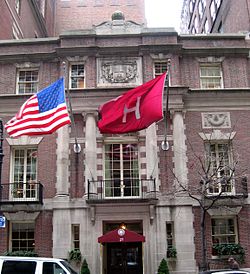|
Harvard Club of New York City
The Harvard Club of New York City, commonly called The Harvard Club, is a private social club located in Midtown Manhattan, New York City. Its membership is limited to alumni, faculty and board members of Harvard University. Incorporated in 1887, the club is located on adjoining lots at 27 and 35 West 44th Street. The original wing, built in 1894, was designed in red brick neo-Georgian style by architect Charles Follen McKim of McKim, Mead & White. HistoryFounded without a location in 1865 by a group of Harvard University alumni, the club rented a townhouse in 1887 on 22nd Street for use as a clubhouse.[3] In 1888, the club acquired land on 44th Street intending to build a new clubhouse there.  After the Penn Club of New York (est. 1901) became the first alumni clubhouse to join Clubhouse Row for inter-club events at 30 West 44th Street[4] after Harvard Club of New York City (est. 1888) at 27 West 44th, then New York Yacht Club (est. 1899) at 37 West 44th, and Yale Club of New York City (est. 1915) on East 44th (and Vanderbilt) and Cornell Club of New York (est. 1989) at 6 East 44th on the same block, with Princeton Club of New York joining in 1963 at 15 West 43rd (the only alumni clubhouse who was not on 44th Street, whose members, part of the staff, and in-residence club, Williams College Club of New York, were absorbed into Penn Club following a previous visiting reciprocity agreement between the Princeton-Penn Clubs, before Princeton's went out of business during COVID).[5][6] Despite being in New York City, Columbia University Club of New York (est. 1901) left Princeton after residence agreement issues[7][8] to become in-residence at The Penn Club, while Dartmouth shares the Yale Club, and Brown shares the Cornell Club. The Harvard Club selected architect Charles Follen McKim, of McKim, Mead & White, for the project. The design was Georgian style architecture with Harvard brick and Indiana limestone. The building's 1894 façade is reminiscent of McKim, Mead and White's 1901 gates at Harvard Yard. In 1905, Harvard Hall, the Grill Room, a new library, a billiard room, and two floors of guest rooms were added. In 1915, McKim, Mead & White doubled the building's size by constructing the Main Dining Room, a bar, additional guestrooms, banquet rooms, and athletic facilities including a 7th floor swimming pool.  In 2003, the architects Davis Brody Bond, under the direction of J. Max Bond Jr., added a 40,000-square-foot annex on West 44th Street, with a façade clad in limestone and fenestrated with large glass windows. Admission of womenIn the spring of 1970, four Harvard Business School students, Ellen Marram, Katie Metzger, Roslyn Braeman Payne, and Lynn Salvage, were turned away from membership interviews at the Harvard Club of New York because it was at the time a male only club.[9]: 10 That fall, Marram and Salvage wrote to Morgan Wheelock, the president of the Harvard Club of New York, to request that women be granted equal membership privileges.[9]: 11 Wheelock rejected the request. In January 1971, Marram and Salvage began a letter-writing campaign to the new president, Albert H. Gordon. A group of Harvard alumni seeking club membership met with Gordon in the fall of 1971, but Gordon initially denied the delegation's request to bring women's membership to a vote.[9]: 12 A Harvard Law School alumnus, Marguerite "Mitzi" Filson, suggested the group take legal action against the Harvard Club of New York.[9]: 12 Marram, Salvage, Metzler, Payne, and Filson, represented pro bono by Jed S. Rakoff, then prepared a gender discrimination claim to file with the New York Commission on Human Rights.[10] In response, Gordon agreed to put the matter to a vote.[9]: 13 Shortly before the vote, several Harvard alumni, including attorney and activist Brenda Feigen, co-founder of the ACLU Women's Rights Project, sued the Harvard Club in federal court, seeking revocation of the club's liquor license on sex discrimination grounds.[11][12] On May 4, 1972, the club voted to deny full membership rights to women.[12] A majority of members (1,654 to 854) supported membership for women, but the vote fell 18 votes short of the required two-thirds needed to amend its membership criteria.[13] Marram, Salvage, Metzler, Payne, and Filson then filed their complaint with the New York Commission on Human Rights.[9]: 15 Commission chairwoman Eleanor Holmes Norton issued a two-page letter condemning the Harvard Club's exclusion of women.[14][15][13] After the parties came before a New York Human Rights administrative judge, the Harvard Club's board of managers called another vote.[9]: 15 On January 11, 1973, the club voted 2,097 to 695 to admit female members.[16] MembershipTo be eligible for election to membership, a candidate must hold a degree or honorary degree from Harvard, be a tenured faculty member at the university, or serve as an officer, or member of any board or committee of the university. Dues levied are on a sliding scale, based on age and proximity to the club. Like most private clubs, members of the Harvard Club are given reciprocal benefits at clubs around the United States and the world.[17] The building is sometimes used for outside corporate events such as business conferences.[18] Notable members
PhilanthropyThe Harvard Club of New York Foundation[21] makes an annual gift to the Harvard College Financial Aid Program, maintains a scholarship fund that helps support 20 undergraduates at Harvard College, supports several Harvard University graduate programs and provides stipends to support Harvard University students to work non-paying, or low paying fields.[22] Gallery
See alsoReferences
Further reading
External linksWikimedia Commons has media related to Harvard Club of New York. |
||||||||||||||||||||||||||||||||||||||










